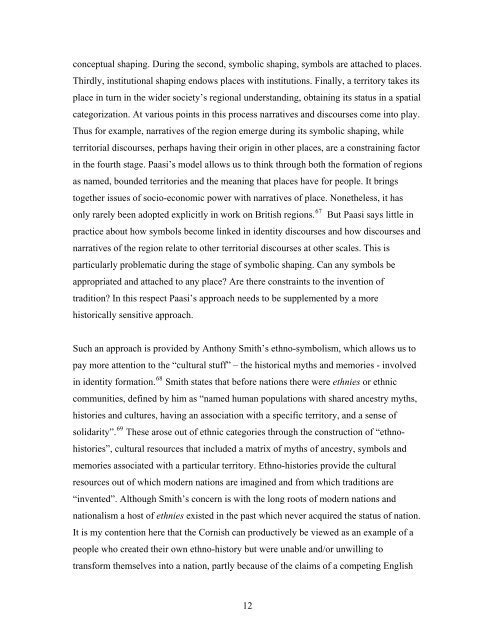Britishness, what it is and what it could be, is now high on both ...
Britishness, what it is and what it could be, is now high on both ...
Britishness, what it is and what it could be, is now high on both ...
Create successful ePaper yourself
Turn your PDF publications into a flip-book with our unique Google optimized e-Paper software.
c<strong>on</strong>ceptual shaping. During the sec<strong>on</strong>d, symbolic shaping, symbols are attached to places.<br />
Thirdly, inst<str<strong>on</strong>g>it</str<strong>on</strong>g>uti<strong>on</strong>al shaping endows places w<str<strong>on</strong>g>it</str<strong>on</strong>g>h inst<str<strong>on</strong>g>it</str<strong>on</strong>g>uti<strong>on</strong>s. Finally, a terr<str<strong>on</strong>g>it</str<strong>on</strong>g>ory takes <str<strong>on</strong>g>it</str<strong>on</strong>g>s<br />
place in turn in the wider society’s regi<strong>on</strong>al underst<str<strong>on</strong>g>and</str<strong>on</strong>g>ing, obtaining <str<strong>on</strong>g>it</str<strong>on</strong>g>s status in a spatial<br />
categorizati<strong>on</strong>. At various points in th<str<strong>on</strong>g>is</str<strong>on</strong>g> process narratives <str<strong>on</strong>g>and</str<strong>on</strong>g> d<str<strong>on</strong>g>is</str<strong>on</strong>g>courses come into play.<br />
Thus for example, narratives of the regi<strong>on</strong> emerge during <str<strong>on</strong>g>it</str<strong>on</strong>g>s symbolic shaping, while<br />
terr<str<strong>on</strong>g>it</str<strong>on</strong>g>orial d<str<strong>on</strong>g>is</str<strong>on</strong>g>courses, perhaps having their origin in other places, are a c<strong>on</strong>straining factor<br />
in the fourth stage. Paasi’s model allows us to think through <strong>both</strong> the formati<strong>on</strong> of regi<strong>on</strong>s<br />
as named, bounded terr<str<strong>on</strong>g>it</str<strong>on</strong>g>ories <str<strong>on</strong>g>and</str<strong>on</strong>g> the meaning that places have for people. It brings<br />
together <str<strong>on</strong>g>is</str<strong>on</strong>g>sues of socio-ec<strong>on</strong>omic power w<str<strong>on</strong>g>it</str<strong>on</strong>g>h narratives of place. N<strong>on</strong>etheless, <str<strong>on</strong>g>it</str<strong>on</strong>g> has<br />
<strong>on</strong>ly rarely <str<strong>on</strong>g>be</str<strong>on</strong>g>en adopted explic<str<strong>on</strong>g>it</str<strong>on</strong>g>ly in work <strong>on</strong> Br<str<strong>on</strong>g>it</str<strong>on</strong>g><str<strong>on</strong>g>is</str<strong>on</strong>g>h regi<strong>on</strong>s. 67 But Paasi says l<str<strong>on</strong>g>it</str<strong>on</strong>g>tle in<br />
practice about how symbols <str<strong>on</strong>g>be</str<strong>on</strong>g>come linked in ident<str<strong>on</strong>g>it</str<strong>on</strong>g>y d<str<strong>on</strong>g>is</str<strong>on</strong>g>courses <str<strong>on</strong>g>and</str<strong>on</strong>g> how d<str<strong>on</strong>g>is</str<strong>on</strong>g>courses <str<strong>on</strong>g>and</str<strong>on</strong>g><br />
narratives of the regi<strong>on</strong> relate to other terr<str<strong>on</strong>g>it</str<strong>on</strong>g>orial d<str<strong>on</strong>g>is</str<strong>on</strong>g>courses at other scales. Th<str<strong>on</strong>g>is</str<strong>on</strong>g> <str<strong>on</strong>g>is</str<strong>on</strong>g><br />
particularly problematic during the stage of symbolic shaping. Can any symbols <str<strong>on</strong>g>be</str<strong>on</strong>g><br />
appropriated <str<strong>on</strong>g>and</str<strong>on</strong>g> attached to any place? Are there c<strong>on</strong>straints to the inventi<strong>on</strong> of<br />
trad<str<strong>on</strong>g>it</str<strong>on</strong>g>i<strong>on</strong>? In th<str<strong>on</strong>g>is</str<strong>on</strong>g> respect Paasi’s approach needs to <str<strong>on</strong>g>be</str<strong>on</strong>g> supplemented by a more<br />
h<str<strong>on</strong>g>is</str<strong>on</strong>g>torically sens<str<strong>on</strong>g>it</str<strong>on</strong>g>ive approach.<br />
Such an approach <str<strong>on</strong>g>is</str<strong>on</strong>g> provided by Anth<strong>on</strong>y Sm<str<strong>on</strong>g>it</str<strong>on</strong>g>h’s ethno-symbol<str<strong>on</strong>g>is</str<strong>on</strong>g>m, which allows us to<br />
pay more attenti<strong>on</strong> to the “cultural stuff” – the h<str<strong>on</strong>g>is</str<strong>on</strong>g>torical myths <str<strong>on</strong>g>and</str<strong>on</strong>g> memories - involved<br />
in ident<str<strong>on</strong>g>it</str<strong>on</strong>g>y formati<strong>on</strong>. 68 Sm<str<strong>on</strong>g>it</str<strong>on</strong>g>h states that <str<strong>on</strong>g>be</str<strong>on</strong>g>fore nati<strong>on</strong>s there were ethnies or ethnic<br />
commun<str<strong>on</strong>g>it</str<strong>on</strong>g>ies, defined by him as “named human populati<strong>on</strong>s w<str<strong>on</strong>g>it</str<strong>on</strong>g>h shared ancestry myths,<br />
h<str<strong>on</strong>g>is</str<strong>on</strong>g>tories <str<strong>on</strong>g>and</str<strong>on</strong>g> cultures, having an associati<strong>on</strong> w<str<strong>on</strong>g>it</str<strong>on</strong>g>h a specific terr<str<strong>on</strong>g>it</str<strong>on</strong>g>ory, <str<strong>on</strong>g>and</str<strong>on</strong>g> a sense of<br />
solidar<str<strong>on</strong>g>it</str<strong>on</strong>g>y”. 69 These arose out of ethnic categories through the c<strong>on</strong>structi<strong>on</strong> of “ethnoh<str<strong>on</strong>g>is</str<strong>on</strong>g>tories”,<br />
cultural resources that included a matrix of myths of ancestry, symbols <str<strong>on</strong>g>and</str<strong>on</strong>g><br />
memories associated w<str<strong>on</strong>g>it</str<strong>on</strong>g>h a particular terr<str<strong>on</strong>g>it</str<strong>on</strong>g>ory. Ethno-h<str<strong>on</strong>g>is</str<strong>on</strong>g>tories provide the cultural<br />
resources out of which modern nati<strong>on</strong>s are imagined <str<strong>on</strong>g>and</str<strong>on</strong>g> from which trad<str<strong>on</strong>g>it</str<strong>on</strong>g>i<strong>on</strong>s are<br />
“invented”. Although Sm<str<strong>on</strong>g>it</str<strong>on</strong>g>h’s c<strong>on</strong>cern <str<strong>on</strong>g>is</str<strong>on</strong>g> w<str<strong>on</strong>g>it</str<strong>on</strong>g>h the l<strong>on</strong>g roots of modern nati<strong>on</strong>s <str<strong>on</strong>g>and</str<strong>on</strong>g><br />
nati<strong>on</strong>al<str<strong>on</strong>g>is</str<strong>on</strong>g>m a host of ethnies ex<str<strong>on</strong>g>is</str<strong>on</strong>g>ted in the past which never acquired the status of nati<strong>on</strong>.<br />
It <str<strong>on</strong>g>is</str<strong>on</strong>g> my c<strong>on</strong>tenti<strong>on</strong> here that the Corn<str<strong>on</strong>g>is</str<strong>on</strong>g>h can productively <str<strong>on</strong>g>be</str<strong>on</strong>g> viewed as an example of a<br />
people who created their own ethno-h<str<strong>on</strong>g>is</str<strong>on</strong>g>tory but were unable <str<strong>on</strong>g>and</str<strong>on</strong>g>/or unwilling to<br />
transform themselves into a nati<strong>on</strong>, partly <str<strong>on</strong>g>be</str<strong>on</strong>g>cause of the claims of a competing Engl<str<strong>on</strong>g>is</str<strong>on</strong>g>h<br />
12
















